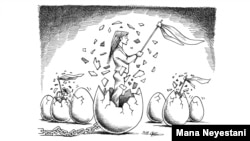At least six women in Tehran and one in the provincial capital Esfahan reportedly defied Iran’s morality police January 29 by removing their head scarves on a busy street, attaching them to a stick, and waving them around like flags.
Images of the women flooded social media in a swell of protest against the compulsory hijab in Iran that was started by a woman who has become known as the “Girl of Revolution Street.”
The word used in Persian can also mean “Daughter of Revolution Street”.
The woman, whose identity has not been confirmed, climbed on top of an electricity box on one of Tehran’s busiest streets, Enqelab (Revolution) Avenue, December 27, 2017, removed her head scarf and began waving it in the air. A video clip of the woman, who appears to be in her early thirties, quickly went viral, and her act has become a symbol of Iranian women’s resistance to the compulsory hijab.
Although the number of women who defied the dress code has not been confirmed, but based on published images, perhaps up to seven women took off their veils or scarves in a show of defiance.
Renowned lawyer, human rights activist, and former political prisoner Nasrin Sotoudeh announced on her Facebook account January 21 that she had visited the spot where the Girl of Revolution Street took off her scarf and proudly waved it like a flag.
According to Sotoudeh’s investigation, the “Girl of Revolution Street” was arrested a day after her courageous move, but freed within hours.
Sotoudeh said she has not been able to confirm the woman’s name, but discovered she is a 31-year-old mother of a 19-month-old baby.
Several social media users have claimed that the woman’s name is Vida Movahed, but there is no proof to confirm the claim.
“I visited the court to see what had happened to the Girl of Revolution Street, and I was informed that she had been arrested but later freed,” said Sotoudeh, adding that in her view the woman had done nothing wrong and should not be punished.
The Islamic Republic’s judiciary has so far not made any comment on the woman’s arrest.
Amnesty International issued a statement January 24 calling for the woman’s unconditional release.
“The Iranian authorities must immediately and unconditionally release a woman arrested on December 27, 2017 in Tehran for engaging in a peaceful protest against compulsory veiling (hijab),” the statement read.
Furthermore, the organization renewed its calls on Iranian authorities to end the persecution of women who speak out against compulsory veiling and abolish this “discriminatory and humiliating practice.”
The practice, according to Amnesty International, has violated women’s rights in Iran for decades, including their rights to non-discrimination, freedom of religion, freedom of expression, and protection from arbitrary detention, torture, and other cruel, inhuman, or degrading punishment.
The hijab has a complicated history in Iran. It was officially forbidden for women to wear head scarves in 1936 during the reign of Reza Shah, the founder of the Pahlavi dynasty. But in 1941 Reza Shah abdicated to the Crown Prince Mohammad-Reza, who relaxed the dress code and allowed women to wear the hijab if they chose.
Just a few months after the establishment of the Islamic Republic in 1979, a law forcing women to not only cover their heads, but also wear loose clothing to hide their figures, came into effect.
The law was spearheaded by Iran’s current President, Hassan Rouhani, who at the time ordered his security agents to prevent women without a hijab from entering government offices he presided over.
Though Rouhani has often criticized the morality police for being too harsh in their enforcement of the hijab rule, he continues to support Iran’s strict dress code for women.
In August 2017, he ordered his newly appointed Deputy for Legal Affairs La’ya Joneidi to wear a chador (a body-length cloak) “according to the cabinet’s protocol.”
Although Joneidi, who holds a doctorate from Harvard University in comparative law and international commercial arbitration, had previously worn the hijab and otherwise complied with the legal dress code, she had little choice but to adopt the super-concealing chador preferred by Iran’s clerics for women.
Women who appear in public without the Islamic hijab can be sentenced to up to two months in prison and be issued a fine up to 500,000 rials (roughly $13).






